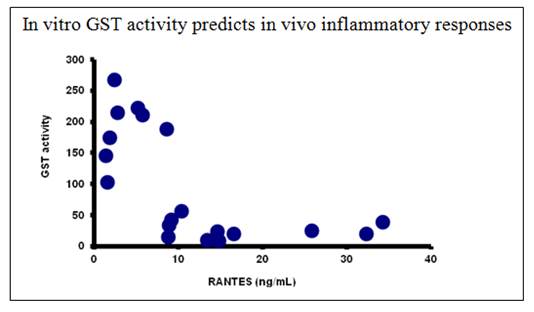Grantee Research Project Results
2007 Progress Report: Pollution-Enhanced Allergic Inflammation and Phase II Enzymes
EPA Grant Number: R831861C002Subproject: this is subproject number 002 , established and managed by the Center Director under grant R831861
(EPA does not fund or establish subprojects; EPA awards and manages the overall grant for this center).
Center: Southern California Children's Environmental Health Center
Center Director: McConnell, Rob Scot
Title: Pollution-Enhanced Allergic Inflammation and Phase II Enzymes
Investigators: Gilliland, Frank D. , Diaz-Sanchez, David
Institution: University of Southern California
EPA Project Officer: Callan, Richard
Project Period: November 1, 2003 through October 31, 2008 (Extended to October 31, 2010)
Project Period Covered by this Report: November 1, 2006 through October 31,2007
RFA: Centers for Children's Environmental Health and Disease Prevention Research (2003) RFA Text | Recipients Lists
Research Category: Children's Health , Human Health
Objective:
There has been no change in the specific aims of this study, they are to study the role of Phase II enzymes in regulating responses to pollutants in: children's upper airways (Aim #1); the lower airways of healthy and asthmatic individuals (Aim #2) and in mechanistic animal and cellular models of allergic inflammation (Aim #3).
Progress Summary:
As of November 1, 2007, Dr. Diaz-Sanchez will no longer be the principal investigator of this project as he has taken a position with the US EPA. In Year 10, this project will continue under the leadership of Dr. Marc Riedl, a close collaborator of Dr. Diaz-Sanchez’ for the past five years. Dr. Riedl is an Assistant Professor of Medicine at the UCLA David Geffen School of Medicine and is Section Head of Clinical Immunology and Allergy.
Aim #1: We will test the hypothesis that Phase II enzyme expression in the upper airways are induced by oxidant pollutants and differ between children and adults.

Future Activities:
In the next year, we intend to continue recruitment of adults and children for Aims #1 and #2 and further develop an in vitro test to predict airway susceptibility to pollutants.
Journal Articles on this Report : 6 Displayed | Download in RIS Format
| Other subproject views: | All 138 publications | 90 publications in selected types | All 89 journal articles |
|---|---|---|---|
| Other center views: | All 202 publications | 132 publications in selected types | All 131 journal articles |
| Type | Citation | ||
|---|---|---|---|
|
|
Cozen W, Avol E, Diaz-Sanchez D, McConnell R, Gauderman WJ, Cockburn MG, Zadnick J, Jyrala M, Mack TM. Use of an electrostatic dust cloth for self-administered home allergen collection. Twin Research and Human Genetics 2008;11(2):150-155. |
R831861 (Final) R831861C001 (Final) R831861C002 (2007) R831861C002 (Final) R831861C003 (Final) |
Exit Exit |
|
|
Diaz-Sanchez D, Rumold R, Gong Jr. H. Challenge with environmental tobacco smoke exacerbates allergic airway disease in human beings. Journal of Allergy and Clinical Immunology 2006;118(2):441-446. |
R831861 (2005) R831861 (2006) R831861 (Final) R831861C001 (Final) R831861C002 (2006) R831861C002 (2007) R831861C002 (Final) R831861C003 (Final) |
Exit Exit Exit |
|
|
Gilliland FD, Li YF, Gong Jr. H, Diaz-Sanchez D. Glutathione s-transferases M1 and P1 prevent aggravation of allergic responses by secondhand smoke. American Journal of Respiratory and Critical Care Medicine 2006;174(12):1335-1341. |
R831861 (2006) R831861 (Final) R831861C001 (Final) R831861C002 (2006) R831861C002 (2007) R831861C002 (Final) R831861C003 (2007) R831861C003 (Final) |
Exit Exit Exit |
|
|
Ritz SA, Wan J, Diaz-Sanchez D. Sulforaphane-stimulated phase II enzyme induction inhibits cytokine production by airway epithelial cells stimulated with diesel extract. American Journal of Physiology-Lung Cellular and Molecular Physiology 2007;292(1):L33-L39. |
R831861 (2006) R831861 (Final) R831861C001 (Final) R831861C002 (2006) R831861C002 (2007) R831861C002 (Final) R831861C003 (Final) |
Exit Exit Exit |
|
|
Wan J, Diaz-Sanchez D. Phase II enzymes induction blocks the enhanced IgE production in B cells by diesel exhaust particles. Journal of Immunology 2006;177(5):3477-3483. |
R831861 (2005) R831861 (2006) R831861 (Final) R831861C001 (Final) R831861C002 (2006) R831861C002 (2007) R831861C002 (Final) R831861C003 (Final) R826708 (2000) R826708 (2001) R826708 (2002) R826708 (Final) |
Exit Exit |
|
|
Wan J, Diaz-Sanchez D. Antioxidant enzyme induction: a new protective approach against the adverse effects of diesel exhaust particles. Inhalation Toxicology 2007;19(Suppl 1):177-182. |
R831861 (Final) R831861C001 (Final) R831861C002 (2007) R831861C002 (Final) R831861C003 (Final) |
Exit |
Supplemental Keywords:
RFA, Health, Scientific Discipline, ENVIRONMENTAL MANAGEMENT, HUMAN HEALTH, Health Risk Assessment, Children's Health, Biochemistry, Health Effects, Risk Assessment, childhood respiratory disease, Human Health Risk Assessment, allergen, asthma, susceptibility, animal model, community-based intervention, airway disease, children's environmental health, outreach and educationProgress and Final Reports:
Original AbstractMain Center Abstract and Reports:
R831861 Southern California Children's Environmental Health Center Subprojects under this Center: (EPA does not fund or establish subprojects; EPA awards and manages the overall grant for this center).
R831861C001 Urban Air Pollution and Persistent Early Life Asthma
R831861C002 Pollution-Enhanced Allergic Inflammation and Phase II Enzymes
R831861C003 Air Pollution, Exhaled Breath Markers, and Asthma in Susceptible Children
The perspectives, information and conclusions conveyed in research project abstracts, progress reports, final reports, journal abstracts and journal publications convey the viewpoints of the principal investigator and may not represent the views and policies of ORD and EPA. Conclusions drawn by the principal investigators have not been reviewed by the Agency.
Project Research Results
- Final Report
- 2009
- 2008
- 2006 Progress Report
- 2005 Progress Report
- 2004 Progress Report
- Original Abstract
89 journal articles for this subproject
Main Center: R831861
202 publications for this center
131 journal articles for this center
